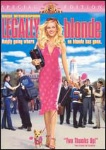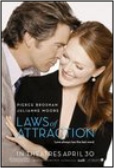|
Girlie Girl Lawyers
by Andrea Remington
Dressed in pink from head to
toe, she strolls down the street and is met with catcalls and
whistles. "I object" she declares. This is Elle Woods:
Harvard law student in Legally Blonde. How far off is
this image of the girly girl meets seriously smart law student?
This is the question that consumed my group of friends just the
other night as we watched Legally Blonde, feasting on
goodies, drinking wine, dressed in our pink Juicy Couture™
sweatpants and other equally fashion-conscious choices. Were
we, female law students, just like Elle Woods? One couldn't help
but admit our gathering reflected similar gendered stereotypes
that Legally Blonde effused. Yet, somehow, none of us
wanted this comparison to be accurate. Which raises the question,
why do we so readily consume popular culture like Legally
Blonde, yet refuse the belief in any parallel? If a character
such as Elle Woods has no influence or credibility in our worlds,
why then do we see it reproduced and replicated as in the case
of Audrey Woods in Laws of Attraction? It's not simply
the shared last name - Elle and Audrey seem to be the modern
gold standard for the representation of women in the law. As
a divorce lawyer, Audrey Woods is not only exceptional in her
intellect, but also her appearance - akin to her student counterpart
Elle. This portrayal of women in the legal profession merits
analysis considering not only the pervasiveness of popular culture
but also the influence it has in informing our understanding
of the world we live in and who we are as women lawyers.
 The construction
of Elle and Audrey as women in these films seems to supersede
the portrayal of their capabilities in law. Although both attain
outstanding achievements in law, graduating top of their classes
at Harvard and Yale respectively, this is shadowed by the emphasis
on their femininity. Placing this emphasis hierarchically, femininity
reigns supreme while professional accomplishments rank inferior.
The obvious implication being that the importance of a woman
in law being stereotypically woman is not only desirable but
necessary. Whether this stems from a North American culture that
values outward appearances or a popular culture that perpetuates
stereotyped roles is debatable. Less controversial is the message
it sends - the premium on femininity is higher than that of legal
intellect or professional accomplishment. Perhaps the clearest
manifestation of this emphasis on femininity in both films is
in the physical representations. Elle and Audrey are exceptionally
beautiful women by modern (albeit stereotyped) standards. Both
women have long flowing hair, excellent make-up, perfect teeth,
slim physiques and clever fashionable outfits. The construction
of Elle and Audrey as women in these films seems to supersede
the portrayal of their capabilities in law. Although both attain
outstanding achievements in law, graduating top of their classes
at Harvard and Yale respectively, this is shadowed by the emphasis
on their femininity. Placing this emphasis hierarchically, femininity
reigns supreme while professional accomplishments rank inferior.
The obvious implication being that the importance of a woman
in law being stereotypically woman is not only desirable but
necessary. Whether this stems from a North American culture that
values outward appearances or a popular culture that perpetuates
stereotyped roles is debatable. Less controversial is the message
it sends - the premium on femininity is higher than that of legal
intellect or professional accomplishment. Perhaps the clearest
manifestation of this emphasis on femininity in both films is
in the physical representations. Elle and Audrey are exceptionally
beautiful women by modern (albeit stereotyped) standards. Both
women have long flowing hair, excellent make-up, perfect teeth,
slim physiques and clever fashionable outfits.
The association between the color pink and notions of femininity
is neither subtle nor accidental in both films. Elle's and Audrey's
dress offers the extreme in femininity - most of the wardrobe
choices are pink. Pink is the ideal ultra-feminine color of choice.
It is not surprising therefore to see it used and abused in Legally
Blonde as well as, though less pervasively so, in Laws
of Attraction. Whereas Elle's use of pink borders on the
unpalatable, Audrey's wardrobe suggests the same affinity without
the embellishment. This physical manifestation of the feminine
serves to reinforce the very make-up of these characters. Make
no mistake about it - these women are not seen wearing the traditional
legal garb, yet at the same time they do not eschew traditional
notions of femininity. On the contrary, their wardrobes embrace
all that is feminine from the pink suits to the lacy undergarments.
The heightened physical portrayal of femininity in these films
is without a doubt matched by the decidedly female characteristics
of Elle and Audrey. Commonly held beliefs of the stereotypical
women are often seen in contrast to the opposite sex: Women are
more emotional than men, women are more concerned with fashion
than men, women are more neurotic about food than men, women
are more inclined to obsess about intimate and personal relationships
than men and women are just simply less competent than men. These
conceptions are clearly delivered in both films.
In Legally Blonde, Elle turns on the tears on several
occasions, primarily in relation to her heart's affection - Warner.
Their romantic break-up causes Elle to spin into the stereotypical
emotional meltdown women go through after being dumped: Elle
spends a week in bed, eating chocolates and watching soap opera's.
Beyond majoring in fashion at university, Elle takes her wardrobe
choices very seriously. From her dedication to manicures and
Cosmopolitan magazine, Elle is always put together and chic.
Yet, even Elle's mastery of fashion is trivialized in the film
- her lavishness and colorful couture is only matched by her
purse-pocket dog Bruiser who is seen wearing a barrage of doggy-sized
outfits. Interestingly enough, as Elle begins to achieve academically,
the film shows her toning down her otherwise gaudy wardrobe.
This suggests that even femininity has its limits - but only
to the extent that there can be too much of a good thing. As
Naomi Wolf suggests in The Beauty Myth, "Femininity
is code for femaleness, plus whatever a society happens to be
selling". Current popular culture informs our ideas of femininity
and what limits should be placed on a woman and her femaleness
- we accept and embrace Elle's femininity, but as soon as she
emerges as a contender in the academic game, we hold her to a
different standard. Her over-the-top-ness is no longer acceptable
- she must now exude control and togetherness in order for us
to believe that she can actually think. Wolf continues to state
that, "[women] are raised to compete like men in rigid male-model
institutions, [women] must also maintain to the last detail impeccable
femininity" This sentiment reinforces the importance of
femininity, particularly in male centered institutions, the law
being a prime example.
Elle's decision to go to law school stems not from her desire
to become a lawyer, but rather to get her boyfriend back. And
even when Elle eventually realizes Warner is not 'the one', he
is quickly replaced by another man. Elle seems to gain credibility
in the audience's eyes by fulfilling the popular stereotype of
'girl lands boy and they live happily ever after'. Again, it
is not enough for Elle to have graduated law school, been Valedictorian
of her class, and secured an articling position at a prestigious
law firm - these truths are eclipsed by the importance of Elle's
femininity.
 In Laws of Attraction,
Audrey attempts confidence and determination in the film yet
her emotions get the best of her at several points. When opposing
counsel changes in Audrey's case, we witness her in the bathroom
at the courthouse, shoving a snowball (a pink sweet) into her
mouth in a moment of anxiety and fear. Throughout the film, the
audience engages in her struggle to maintain composure in and
out of the courtroom with less than subtle hints as to what lies
beneath the surface. These emotions emerge predominantly in her
dealings with Daniel Raferty, the other divorce lawyer in the
film. Audrey's emotional being is most obvious in contrast to
her leading man. Daniel consistently fulfills the opposite stereotype
- that of a cool and collected male whose emotions don't come
as a sacrifice to his competence or control. In Laws of Attraction,
Audrey attempts confidence and determination in the film yet
her emotions get the best of her at several points. When opposing
counsel changes in Audrey's case, we witness her in the bathroom
at the courthouse, shoving a snowball (a pink sweet) into her
mouth in a moment of anxiety and fear. Throughout the film, the
audience engages in her struggle to maintain composure in and
out of the courtroom with less than subtle hints as to what lies
beneath the surface. These emotions emerge predominantly in her
dealings with Daniel Raferty, the other divorce lawyer in the
film. Audrey's emotional being is most obvious in contrast to
her leading man. Daniel consistently fulfills the opposite stereotype
- that of a cool and collected male whose emotions don't come
as a sacrifice to his competence or control.
Audrey's fashion sense and the importance thereof is seen not
only through her dress, but also in her remarks to Daniel. She
frequently comments on his lack of attention to his wardrobe
and at one point buys him a tie. And even though Audrey may appear
to derive an element of capability from her fashion know-how,
the film makes it clear that this doesn't really matter - dressing
well does not win court cases. Audrey's neuroticism is portrayed
through food, her weakness with sugar and sneaking of goodies,
but also generally as in her rigidity in the courtroom needing
to have her paper and markers laid out just so. Audrey's incompetence,
particularly in contrast to Daniel, permeates the film. Initially
she is clearly caught off guard by newly appointed opposing counsel
(Daniel) and rightly so - her motion was ill-informed and embarrassing.
The film continues this theme from Audrey losing her star client
to Daniel to her inability to rent a car in Ireland (but of course
she is later on rescued by Daniel). On the surface, the film
could seem to portray a woman lawyer in a position of power at
her firm, with great successes, loads of confidence who is all
too happy to be alone. As the film unravels however, the audience
is shown that this is all just a façade for who Audrey
really is - a lonely, vulnerable woman who desperately wants
the love of a man.
The roles of Elle and Audrey Woods in both films are not entirely
devoid of positive factors. Both leading ladies are portrayed
as successful, ambitious and professional women. While this has
tremendous appeal for me and other women in law school, what
is difficult to digest is the message these films are sending
- that although academic achievements and legal prowess are important,
it is more important to attain and display a certain degree of
femininity. This is not to say that all women in law must be
over-the-top feminine to reach their goals, but popular culture
suggests that an element of femininity is necessary in and above
any other successes. As Naomi Wolf points out "the more
legal and material hindrances women have broken through, the
more strictly and heavily and cruelly images of female beauty
have come to weigh upon us" (1)
. This is neither a new nor shocking message - cultural socialization
taught us at a young age that women are supposed to look/be pretty
not look/be smart. And even though the times are changing such
that many women are entering traditionally male-dominated professions
such as law, both Legally Blonde and Laws of Attraction
make me wonder how far we've really come.
1.
Ibid. 10
Posted February 25, 2005
|